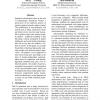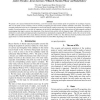33 search results - page 1 / 7 » Constrained Lexical Attraction Models |
FLAIRS
2006
13 years 6 months ago
2006
Lexical Attraction Models (LAMs) were first introduced by Deniz Yuret in (Yuret 1998) to exemplify how an algorithm can learn word dependencies from raw text. His general thesis i...
ACL
1997
13 years 6 months ago
1997
This paper introduces new methods based on exponential families for modeling the correlations between words in text and speech. While previous work assumed the effects of word co-...
IJCNLP
2005
Springer
13 years 10 months ago
2005
Springer
Abstract. Lexical Conceptual Structure (LCS) represents verbs as semantic structures with a limited number of semantic predicates. This paper attempts to exploit how LCS can be use...
ACL
2009
13 years 2 months ago
2009
Sentiment classification refers to the task of automatically identifying whether a given piece of text expresses positive or negative opinion towards a subject at hand. The prolif...
LREC
2010
13 years 6 months ago
2010
We present LIPS (Lexical Isolation Point Software), a tool for accurate lexical isolation point (IP) prediction in recordings of speech. The IP is the point in time in which a wor...


